Review: Anker PowerCore II 20000 mAh

Anker’s second version of its PowerCore 20000 sets a new standard for big power banks. With a high-quality battery, slim construction, multiple ports, and fast-charging capabilities, it’s one of the best power banks you can buy. Just how good is it? Read on to find out.
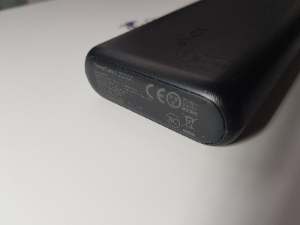
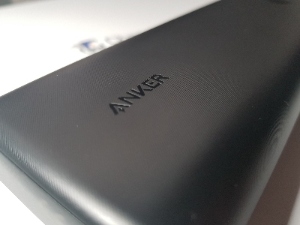
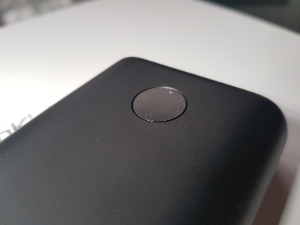
Pros & Cons:
Pros:
- Superb recharging speed
- Amazing simultaneous charging speed
- Two high-quality USB-A ports for output charging
- Slim and well-built for a battery of this capacity
Cons:
- Lack of USB-C
- Only average battery efficiency
Rating
Power & Performance (1 to 5 stars)
Design & Build (1 to 5 stars)
Technology (1 to 5 stars)
Overall Rating (average of above)
Key Product Specifications
Key Specs:
Capacity
20,100 mAh / 72.36 Wh
Dimensions (LxWxH)
6.7 x 2.4 x 0.9 in / 17 x 6.2 x 2.2 cm
Weight
13 oz / 369 g
Output & Input Charging:
Average Charging Time of a Mobile Phone (average battery capacity 3000mAh)
Standard charging: 2 hours
Fast charging: 1 hour and 10 minutes
Average Recharging Time (from 0% to 100%)
Standard charging: 8 hours and 10 minutes
Fast charging: 6 hours and 50 minutes
Ports
- Micro USB PowerIQ 2.0 Input: 5V/2A, 9V/2A (18W)
- USB-A Output: 5V/2.4A (12W)
- USB-A PowerIQ 2.0 Output: 5V/3A, 9V/2A, 12V/1.5A (18W)
Charging Technology
- PowerIQ 2.0 - optimize the highest charging speed for your device
- MultiProtect system ensure total protection for you and your devices
Flight Status
- Under 100WH
- Safe to take on board.
Other Features
- 18-Month Limited Warranty
- Lifetime Technical Support
Ideal For?
- Travelers
- Students
- Adventurers
- Businesspeople
What’s Inside?
- Anker PowerCore II 20000
- Protective pouch
- USB-A to Micro-USB cable
- Manual in multiple languages
- Welcome card
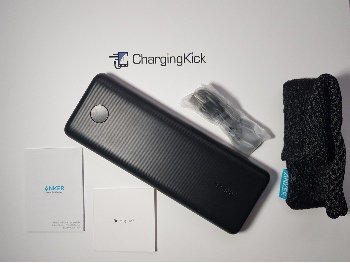
Power & Performance
Battery Capacity
Battery capacity in mAh and Watts
The Anker PowerCore II 20000 has a battery of 20,100 mAh / 72.36 Wh. It’s a big battery that should charge most mobile phones at least 5 times.
Capacity test: discharge the fully charged power bank
Have you ever wondered whether a power bank has its battery capacity? Does it really have 5,000 mAh or 10,000 mAh, as advertised? What is the real battery capacity?
To check the actual battery capacity we need:
The fully charged power bank
A USB tester that shows the current, voltage, mAh, and charging time.
The USB mini adjustable load receives energy from the power bank and releases it safely via the fan. This is the safe way to discharge a fully charged power bank and measure the real battery capacity.
I connect the dummy load (amperes are set to 2) to the USB tester, then plug it into the fully charged power bank. Once that’s done, I wait until the power bank’s battery goes flat. The screen on the USB tester will display the Watt-hours and the amount of mAh consumed. These data show the real battery capacity.
Using the aforementioned procedure, I tested Anker PowerCore II 20000mAh. Here are the results:
Capacity Test

Discharge Time - 6 hours and 4 minutes
Watt-Hours - 62 Wh
Ampere hour - 12,195 mAh
The real battery capacity is 12,195 mAh. This mAh measurement shows you the energy you will fully use to charge your mobile phone. It’s not 20,000 mAh because the unit is converting energy from 3.7V (the power bank’s battery voltage) to 5V (USB voltage). This loss occurs in every power bank.
When you know the advertised and real battery capacity, it’s possible to measure the battery efficiency, which in this case is 82%. Manufacturers frequently don’t share this information. Efficiency above 90% is considered very good. It’s a solid battery, meets the average, but the expectations are set higher.
Disclaimer: Every test can produce different results, but only small variations.
How many times can you charge the most popular mobile phones in 2020?
To put the battery capacity into perspective, I will use a formula for Real Battery Capacity and calculate how many times the Anker PowerCore II 20000 can charge the top 10 most popular mobile phones in 2020. Perhaps you own one of them, or at least you know your mobile phone’s battery capacity.
From the previous test, we know the real battery capacity is 12,195 mAh.
Once we know the real battery capacity, we simply divide it by the enlisted mobile phones’ battery capacity to find out how many times it can be charged.
Mobile Phone Model | How Many Times Can It Be Charged? |
4.61 | |
3.05 | |
2.88 | |
2.88 | |
3.24 | |
7.13 | |
2.88 | |
4.13 | |
3.09 | |
2.60 |
The PowerCore 20000’s big battery can charge any phone more than twice. Mobiles phones with batteries under 3,000 mAh should be easily charged 4 or more times, and smartphones with batteries over 4,000 mAh should charge 3 times. This power bank is ideally suited for heavy-duty tasks and multi-day trips in places without access to electricity.
Output Charging
Charging Time & Power Usage
Power banks are used mainly to charge devices. Therefore, this review would not be completed without testing output charging. For this, knowledge of the device’s charging time is crucial. Frequently it is one of the most important factors in the purchase of a power bank.
For these tests, I used two mobile phones:
Huawei P10 with a battery of 3200 mAh (Huawei SuperCharge)
Samsung S8 with a battery of 3000mAh (Adaptive Fast Charging)
Both phones support fast-charging technology.
To record data (current, voltage, mAh, time) I used a USB tester.
Real-life examples of test-charged phones demonstrate what you can expect after purchasing a power bank.
The Anker PowerCore II is equipped with two USB ports for output charging: 5V/2.4A (12W) and a Quick Charge at the maximum charging rate of 18W. It was a smart choice to provide two different rated ports. Charging at a faster speed might increase heat and use more energy. If you’re not in rush, it’s better to use the 5V/2.4A port. Now let’s find out how good this power bank is.
Charging via USB-A (Huawei)
%20-%20Finish.jpg?alt=media&token=38dc6f9e-2b2a-440e-bcbe-831124734bff)
Two hours and 6 minutes for a full charge! This is not the time I expected, since I used the Quick Charge port and the Huawei P10 is compatible with fast charging. Most of the time, the charging rate was 5V/1.2A, which is less than the port’s capabilities. The power bank delivered 2,281 mAh / 11.6 Wh in total.
Charging via USB-A (Samsung)
%20-%20Finish.jpg?alt=media&token=72752f86-396d-4dfc-a28e-c30e4e3794ff)
One hour and 7 minutes! This is an amazing time. The charging speed was 9V/1.4A and the Samsung S8 instantly detected fast charging. The USB tester didn’t show accurate mAh because the voltage was higher than 5V. However, Watts are correct and amount to 9.45 Wh. Knowing the Wh, we can calculate mAh, which was 1,890 mAh.
Charging two phones simultaneously
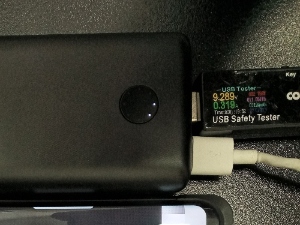
One hour and 19 minutes to charge two phones! That’s a phenomenal time! Surprisingly, when charged simultaneously with another phone, the Huawei P10 charged faster than it did on its own. The power bank delivered around 4,400 mAh in total. The data is not accurate due to the port layout (not enough space to connect two USB testers) and the higher voltage.
Roundup of output charging
Overall, an impressive output charging result. The Samsung S8’s charging time might have been the fastest amongst all the devices in Charging Kick. Simultaneous charging was also beyond expectations. Surprisingly, the Huawei P10 charged very slowly despite the power bank’s considerable capabilities, perhaps there was an issue with the cable.
Input Charging
The power bank can be recharged at 5V/2A or 9V/2A. The manufacturer claims that via a wall fast charger rated at minimum 18W, the power bank can be recharged within 5.5 hours. With a standard wall charger 2 Amp it will take around 8 hours to charge the power bank fully.
I charged the power bank twice. The first test, via a standard charger rated at 5V/2A charging speed; a charger most of us have. For the second charge, I used the charger rated 65W, the fastest type of charger, able to charge compatible laptops.
Recharging via Huawei Charger 5V/2A
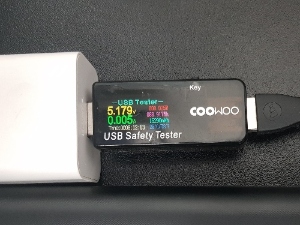
8 hours and 12 minutes to full charge – the time I expected. The power bank received a total of 15,230 mAh / 88.9 Wh.
Recharging via RAVPower Fast Charger
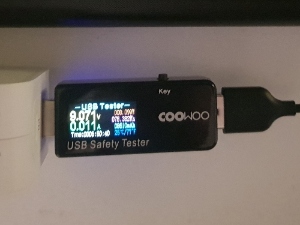
6 hours and 50 minutes to full charge. Not as fast as the manufacturer claims, but it's still a phenomenal time for a power bank with a 20,000 mAh battery. The power bank received 15,676 mAh / 89.9 Wh of energy in total.
Roundup of input charging
This unit has a really good recharging time for a battery of this capacity. You’ll have a full battery after an overnight charge.
Score
Design & Build
Dimension & Weight
Weight in ounces and grams
13 oz / 369 g
Measurement in inches and centimeters
6.7 x 2.4 x 0.9 in / 17 x 6.2 x 2.2 cm
The Anker PowerCore II 20000 is relatively compact for its battery capacity. It's small enough to slide into your pocket while charging your mobile phone.
Design & Material
It features Anker’s typical design and build: minimalistic and sturdy.
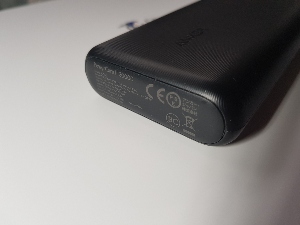
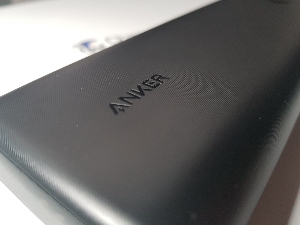
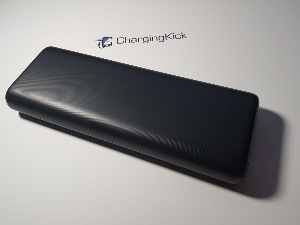
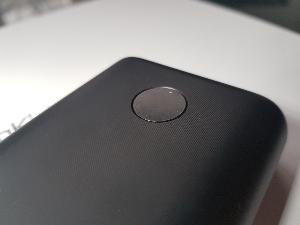
The power bank is available only in plain black.
The material quality of The Anker PowerCore II 20000 is amazing. Although it’s made of plastic, you can feel the superb quality. The numerous small lines that cover the power bank make this device nice to touch and easy to grip. Those lines also prevent smudges and fingerprints. An average-sized hand can easily hold the power bank.
Essentially, the power bank is built of four parts that are strongly connected to each other. Two big parts cover the front and the back of the device, whereas the small parts are on the sides.
On the front part is Anker’s logo. On the opposite side of the logo is a circular power button/battery indicator. Once you press the button, it shows 8 white LEDs that indicate the battery level. Each light indicates 12.5% of a battery. I find it more accurate than the standard four lights. Furthermore, the combination of a power button and battery indicator presents better.
Above the power button on the edge are the ports: two USB-A ports for output charging and one micro-USB for charging the battery itself. The port on the left supports 12W (standard charging) and the one in the middle supports 18W (fast charging). The port on the right side is a micro-USB port for input charging.
Overall, this model is all about simplicity and functionality.
Score
Technology
Ports
The Anker PowerCore II 20000 is equipped with two USB-A ports for output charging and one micro-USB port for input charging. This is an absolute minimum for a power bank of this battery capacity. Sadly, this model doesn’t have an USB-C which has already become a standard in power banks. Furthermore, frequently USB-C ports can be used for input and output charging.
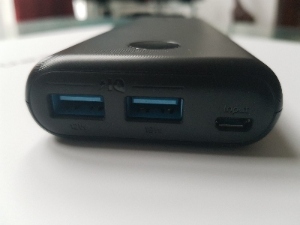
Micro USB PowerIQ 2.0 Input: 5V/2A, 9V/2A (18W)
USB-A Output: 5V/2.4A (12W)
USB-A PowerIQ 2.0 Output: 5V/3A, 9V/2A, 12V/1.5A (18W)
Tech
Whenever you buy Anker’s products, you can count on the newest technological solutions. The most important feature in this power bank is PowerIQ 2.0. This technological feature finds the highest possible charging speed for the charged device, so your mobile phones can not only be charged multiple times, but also at high speeds.
The second port is a standard port rated at 5V/2.4A that will not charge your phone as quickly as the first one. At first, this might seem like a disadvantage. However, the flaw of fast charging is that the extra heat it generates increases energy usage, so you lose the battery’s stored energy faster. Having a standard port can be useful if you’re not in a rush. Charging your devices is slower, but retains more energy in the battery.
Score
Conclusion
Overall Opinion
The Anker PowerCore II 20000 is one of the best 20,000 mAh battery power banks. Two USB ports, fast charging abilities, both input and output and a slim build put this device on top. Sadly, it doesn’t have USB-C and LED digital battery indicator, which would make this the perfect power bank.